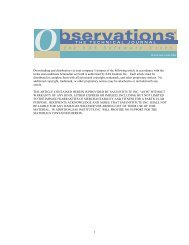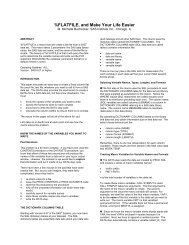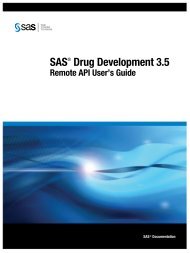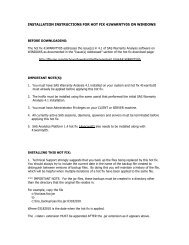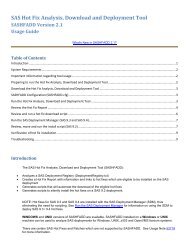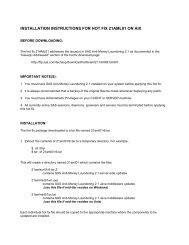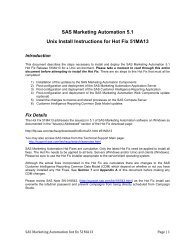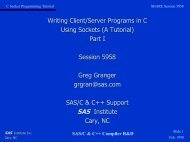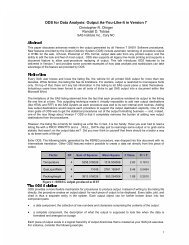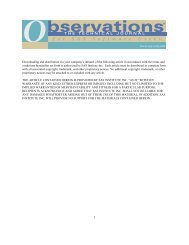SAS 9.3 Web Applications: Clustering - Index of - SAS
SAS 9.3 Web Applications: Clustering - Index of - SAS
SAS 9.3 Web Applications: Clustering - Index of - SAS
Create successful ePaper yourself
Turn your PDF publications into a flip-book with our unique Google optimized e-Paper software.
8 Chapter 2 / Common Pre-Configuration Tasks<br />
Example Code 2.1 Repository.xml with DbFileSystem Class<br />
<br />
<br />
...<br />
Example Code 2.2 Repository.xml with LocalFileSystem Class<br />
<br />
<br />
<br />
2 If the repository.xml file uses the LocalFileSystem class, then follow the steps in<br />
“Reconfiguring the <strong>SAS</strong> Content Server to Use a Database for Storage” in<br />
Chapter 9 <strong>of</strong> <strong>SAS</strong> Intelligence Platform: Middle-Tier Administration Guide. When<br />
performing those steps, instead <strong>of</strong> recreating a directory named Repository,<br />
create a directory named <strong>SAS</strong>Server2.<br />
Return here after reconfiguring <strong>SAS</strong> Content Server to use a database for<br />
storage.<br />
3 For each <strong>Web</strong> application server instance in the cluster, create a directory in the<br />
<strong>SAS</strong>ContentServer directory that is named for the <strong>Web</strong> application server<br />
instance name, such as <strong>SAS</strong>Server2. (Deployments that just reconfigured <strong>SAS</strong><br />
Content Server to use a database already have a <strong>SAS</strong>Server2 directory<br />
instance.)<br />
The name <strong>of</strong> the directory must match the value <strong>of</strong> the<br />
-Dsas.appserver.instance.id JVM option:<br />
mkdir <strong>SAS</strong>-config-dir/Levn/AppData/<strong>SAS</strong>ContentServer/<strong>SAS</strong>Server2<br />
Note: If the <strong>Web</strong> application server instances are deployed on separate<br />
machines, then create the directory and parent directories on each machine. Use<br />
the <strong>Web</strong> application server instance name that runs on the applicable machine<br />
as part <strong>of</strong> the path.<br />
4 Copy the <strong>SAS</strong>Server2/repository.xml file into each <strong>of</strong> the directories<br />
created in step 3. If <strong>SAS</strong> Content Server was configured by the <strong>SAS</strong> Deployment<br />
Wizard to store content in a database, then copy the Repository/<br />
repository.xml file instead.<br />
5 Edit each <strong>of</strong> the copied repository.xml files and set the node ID by uncommenting<br />
the Cluster element and setting the value <strong>of</strong> the id attribute to the <strong>Web</strong><br />
application server instance name. As with step 3, the value must match the value<br />
for the -Dsas.appserver.instance.id JVM option:<br />
<br />
<br />
<br />
<br />
<br />
<br />
<br />
<br />
<br />
<br />
6 Select one host and port to use for setting the -Dsas.scs.host and -Dsas.scs.port<br />
JVM options on all the other <strong>Web</strong> application server instances. These settings<br />
are used by <strong>SAS</strong> <strong>Web</strong> Infrastructure Platform for accessing <strong>SAS</strong> Content Server.




